|
|
|
Sort Order |
|
|
|
Items / Page
|
|
|
|
|
|
|
| Srl | Item |
| 1 |
ID:
165536
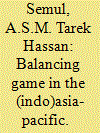

|
|
|
|
|
| Summary/Abstract |
The (re)emergence of China and the relative decline of the power of the United States (US) as the unipolar super power has shifted the geostrategic centre of gravity towards the Asia-Pacific region, also known in its extended form as Indo- Pacific region. Multiple new and frozen flashpoints have emerged in this region as China is increasingly seeking to tilt the power balance in its favour and the US is growing doubtful and impatient regarding the Chinese intentions. To mitigate the China threat, the US has already rebalanced its foreign policy under the Obama administration from the Middle East to the Pacific and current President Trump has extended the geographical reach of his new grand strategy of Free and Open Indo-Pacific to bring the Indian Ocean into play. One of the most predominant discourses that tries to explain this emerging great power relation and power transition is the ‘Thucydides Trap’. This discourse maintains a binary understanding that in a bipolar setting, the rise and decline of great powers make war inevitable. However, this oversimplified assumption may lead to a limited understanding of a region which has emerged with the support of the liberal order and slowly replacing the West as the epicentre of economic progress. This paper argues that there are ‘other discourses’ where middle and smaller regional powers not necessarily stranded between great power rivalry, rather they renegotiate the order in the (Indo)Asia-Pacific region to create multipolarity. On the contrary, the interdependence of the US and China in a globalized world compels the great powers to find ways to keep peace in the troubled waters of the Indo-Pacific. To find out to what extent all these discourses are intertwined and influence each other is another objective of this paper.
|
|
|
|
|
|
|
|
|
|
|
|
|
|
|
|
| 2 |
ID:
158052
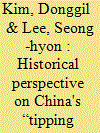

|
|
|
|
|
| Summary/Abstract |
The view that China would not “abandon” North Korea, despite repeated provocations by North Korea, has been strengthened in the context of the US pivot to Asia, which is generally regarded by Chinese strategists as Washington's ploy to contain China. As the rivalry and competition between Washington and Beijing deepen, North Korea's strategic value to China increases. However, history shows that Beijing regarded Pyongyang as “expendable” even during the Korean War. Based on Sino–North Korean historical relations, in this article we argue that China's policy toward North Korea is not fixed but fluid, and that Washington and Seoul could inspire changes within China's policy toward North Korea.
|
|
|
|
|
|
|
|
|
|
|
|
|
|
|
|
| 3 |
ID:
152899
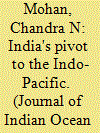

|
|
|
| 4 |
ID:
163318


|
|
|
|
|
| Summary/Abstract |
Since the 1980s, Japan’s war memory has strained its relations with South Korea and China, to a less degree, the USA. Two of the thorniest issues are the comfort women and the US atomic bombing of Japan. Before the Obama administration announced its policy pivot to Asia in 2011, both Japanese and American leaders were reluctant to make amends for the past acts of their countries. However, in 2015, the Japanese conservative Prime Minister Abe reached an agreement with South Korea that “finally and irreversibly” resolved the comfort women issue, thus achieving a historic reconciliation between the two countries. In 2016, then President Obama visited Hiroshima to commemorate the atomic bomb victims. Then, in December 2016, the comfort women issue resurfaced in Japan and South Korea relations, indicating a failure of the reconciliation. Why did the USA change its policy on historical issues involving Japan? Why did Abe and the South Korean President Park Geun-hye settle the comfort women issue? Why did Obama visit Hiroshima? Why did the reconciliation fail? In this article, I propose a rational choice theory to answer these questions. Applying the proposed theory and relying on available evidence, I argue that the settlement of the comfort women issue and Obama’s visit to Hiroshima are important components of Obama’s pivot to Asia to balance China’s rise. The reconciliation failed mainly because it did not resolve the historical justice issue promoted by the human rights norms. I discuss some implications for reconciliation in Northeast Asia.
|
|
|
|
|
|
|
|
|
|
|
|
|
|
|
|
| 5 |
ID:
145229
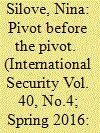

|
|
|
|
|
| Summary/Abstract |
American critics of the Barack Obama administration's 2011 “pivot to Asia” policy claim that, despite the lofty rhetoric, the United States has pursued an anemic strategy in Asia. Chinese critics of the pivot to Asia assert that it is a bellicose strategy aimed at containing China's rise. These two conflicting criticisms are addressed in a detailed historical narrative that traces the development and implementation of U.S. strategy, based on declassified documents, some of which have never before been made public, and extensive in-depth interviews with senior policymakers. Neither American nor Chinese critics of the pivot to Asia are correct. If this policy is properly dated and measured, the United States undertook a substantive military, diplomatic, and later economic reorientation toward Asia. That reorientation started in the mid-2000s, well before the pivot announcement. The aim of the reorientation was not to contain China's rise. Rather, the United States sought to manage China's growth through a blend of internal and external balancing combined with expanded engagement with China. These means were intended to work symbiotically to expand the combined power of the United States and its allies and partners in Asia, and to dissuade China from bidding for hegemony. The ultimate effect of the reorientation strategy—if successful—would be to preserve the existing power balance in the region, in which the United States has held the superior position.
|
|
|
|
|
|
|
|
|
|
|
|
|
|
|
|
| 6 |
ID:
152845


|
|
|
| 7 |
ID:
126452
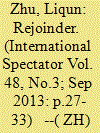

|
|
|
|
|
| Publication |
2013.
|
| Summary/Abstract |
This rejoinder to Daniel Twining's article in the last issue (48:2, June 2013) of The International Spectator argues that both China and the United States recognise how important their relationship is for the world and the Asia-Pacific in particular. But the risk of tension on the security front has increased recently due to the US' policy toward maritime disputes that has actually involved meddling between the parties involved, and its 'pivot' to Asia which targets China with more military engagement in the region. The China-US relationship has never been an easy one with the US certain of its primacy and China proud of its glorious past, which almost makes a conflictual power transition a self-fulfilling prophecy. Management of the relationship is the key for both countries to bring about more cooperation and to rein in competition. Co-evolution, a new type of relationship among major countries, is the only way out, in which the logic of interaction is 'live-and-let-live' rather than mors tua, vita mea.
|
|
|
|
|
|
|
|
|
|
|
|
|
|
|
|
| 8 |
ID:
192502


|
|
|
|
|
| Summary/Abstract |
Despite the well-known "detachment" of Asia from European conflicts, Russia's special military operation in Ukraine, launched in February 2022, affected Russia's ties with the Democratic People's Republic of Korea (DPRK) and the Republic of Korea (ROK). While the DPRK openly supported Moscow, Seoul joined Western countries in condemning Russia's actions. However, when assessing the real prospects for the development of relations with our Korean neighbors, it is not difficult to notice many nuances.
|
|
|
|
|
|
|
|
|
|
|
|
|
|
|
|
| 9 |
ID:
120376
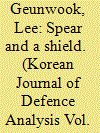

|
|
|
| 10 |
ID:
142634
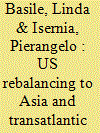

|
|
|
|
|
| Summary/Abstract |
The US policy of ‘rebalancing to Asia’ is likely to have major implications for transatlantic relations as well as for the role of rising powers, such as China. US public opinion and leaders are largely aware of this eastward shift in attention and this awareness can be considered, albeit in a somewhat indirect way, an indicator of support for the policy. On the other side of the Atlantic, however, Europeans seem to be less aware of the fact that the Far East is becoming the main chessboard of international relations in a multipolar global order. Nevertheless, when objectively informed about China, people on both sides of the Atlantic are less in favour of a shift in interests toward Asia and their negative perceptions of China are significantly correlated to a hesitancy in supporting a rebalancing policy. Moreover, if people perceive Beijing as a threat, especially an economic threat, they are even less likely to support a shift of interests to the Far East, the only exception being American elites, who tend to increase their support for the rebalancing strategy in the presence of a Chinese economic threat.
|
|
|
|
|
|
|
|
|
|
|
|
|
|
|
|
|
|
|
|
|